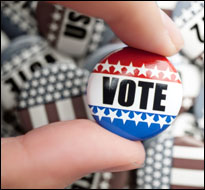Polls in the United States continue to show that the struggling economy remains a key issue for voters. What effect, if any, will the current unemployment rate have on voter turnout in the upcoming presidential election? Prior scholarship has suggested that economic hardship will translate into fewer people at the polls in November due to decreased resources, alienation from the political system and distraction because of individual problems. However, a 2012 study from the University of Wisconsin-Madison and Marquette University, “Unemployment and Voter Turnout,” offers support for an alternative scenario.
The study, presented at the 2012 annual meeting of the American Political Science Association, analyzes U.S. Bureau of Labor Statistics data from 1976 to 2008 and takes account of data on other conditions that may impact voter turnout — for example, the degree of competitiveness in the election, and if gubernatorial or senatorial elections were also on the ballot. The researchers examine voter turnout in nine presidential selection at the state, county and individual levels.
Key study findings include:
- The data show that “that increases in the unemployment rate are associated with higher — not lower — levels of voter turnout. This is a genuinely new finding that contradicts what little political science scholarship exists on the question of how the economy affects voter participation.”
- While higher unemployment rates may mean more unemployed voters at the polls, “both the unemployed and those not in the labor force tend to vote at lower rates (all else equal) than those with a job.” The gap between employed and unemployed voters is smaller in states with higher levels of unemployment.
- At the state level, a state’s voter turnout increases by one percentage point for every two-percentage point increase in a state’s unemployment rate.
- A state’s unemployment rate has a greater effect on county voter turnout than the county rate, even though the latter indicator “is closer to capturing the experiences of one’s local community.” The researchers suggest that the electorate’s awareness of the state, and not county, unemployment rate as reported in the media may play a role in this finding.
The researchers conclude that “when employment rises and falls, it seems that the electorate responds in a fairly informed fashion, increasing participation when unemployment rates worsen. This is bad news for an incumbent of either party.”
A related 2012 study in the American Political Science Review, “Unemployment and the Democratic Electoral Advantage,” also challenges the traditional understanding that incumbents are rewarded when unemployment is low and punished when it is high. That study finds that higher unemployment rates typically benefits Democratic candidates — especially when Republicans are the incumbents — as the issue of “unemployment” is understood as a Democratic party issue. “When unemployment is high or rising, Democratic candidates can successfully convince voters that they are the party best able to solve the problem.”
Tags: economy


Expert Commentary